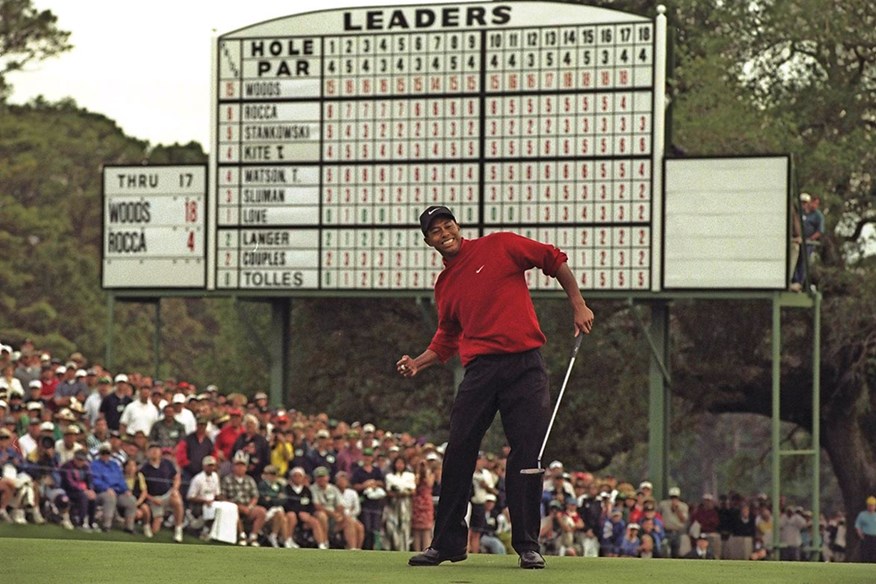“I thought he had no chance” – How Tiger Woods’ shock 1997 Masters win transformed golf forever
Last updated:
At a golf club with a troubled history of racial segregation, Tiger Woods arrived at the 1997 Masters tournament with fire in his eyes. By the time he left Augusta National, he had changed the game forever.
After a couple of relatively forgettable showings at the Masters as an amateur in 1995 and 1996, few could’ve guessed what was coming next. But when Tiger Woods arrived at Augusta in 1997 for his first crack at the Green Jacket as a pro, the Masters – and the game of golf itself – would never be the same again.
Tiger’s previous two appearances at Augusta as an amateur gave little warning of what was to come: a T41 finish in 1995, a missed cut in 1996. But, by the spring of 1997, everything had changed. Woods had turned professional just seven months earlier, fresh off winning a third consecutive U.S. Amateur title. In that short time, he’d already collected three PGA Tour wins and rocketed into the spotlight.
Tiger’s presence alone was seismic. The Masters had only invited its first black competitor, Lee Elder, in 1975. Now, here was Woods — bold, brilliant, and billed as golf’s future — teeing it up with expectations so high they seemed impossible to meet. Having been groomed for greatness by his father, Earl, and mother, Kultida, Woods was the most intriguing newcomer in years. Yet there were doubts.
Tiger’s doubters
“There were still question marks prior to that Masters,” recalls Brad Faxon, who played that week. “I don’t think anybody saw the domination coming.”
The USGA’s David Fay feared the jump from winning amateur to Masters champion was just too wide. “He hadn’t been knocking on the door as an amateur in majors,” he said.
Ron Sirak, then with the Associated Press, was equally skeptical: “I thought he had no chance. The Masters was a place where you needed a track record and experience.”
All opinions that look ridiculous in hindsight, but were completely valid at the time. All of which made what followed over those next four days one of the greatest stories golf has ever told. It was more than just a surprising win – it was a revolution.
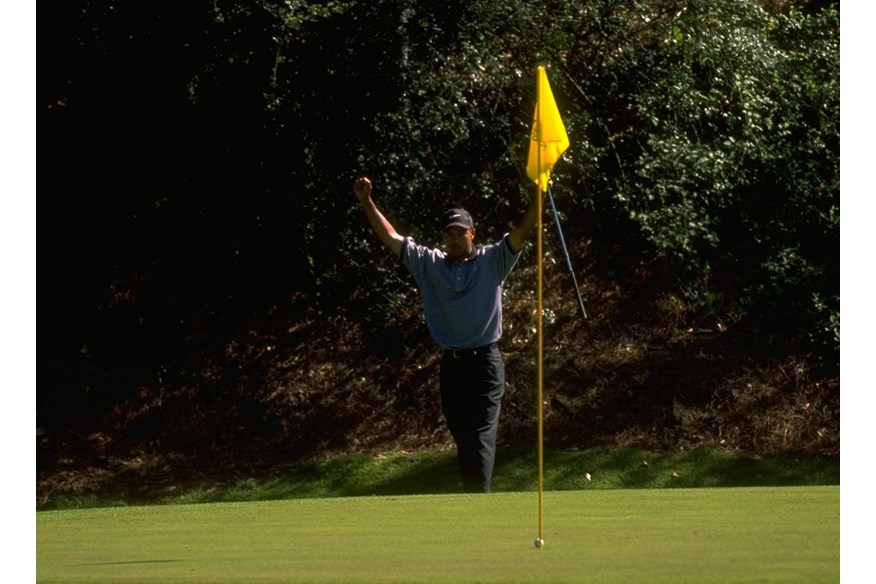
Round one – A game of two halves
Tiger’s first round as a professional at Augusta didn’t start like history in the making. He teed off on Thursday afternoon and played the opening nine holes like a rookie battling nerves. Four bogeys, five pars, zero birdies. Out in 40. For a moment, the hype train wobbled.
Then he made the turn.
Mike “Fluff” Cowan, Tiger’s caddie at the time, kept things simple: “I just told him, ‘Long way to go, hang in there, play a good nine and we’ll go from there.’ And he did.”
Standing on the 10th tee, something clicked. He striped his drive down the fairway, made his first birdie, and never looked back. He chipped in for birdie on 12. The comeback was instant — a blistering 6-under-par 30 on Augusta’s back nine turned what could’ve been a disaster into a statement. An opening 2-under 70 put him three off the lead, but suddenly he was the man to watch.
Ron Sirak, Golf writer, Associated Press: “To have a man of color coming into that tournament like he did was a big deal. When Tiger teed off on the first hole Thursday, many of the black club employees came out to watch him. You could feel how important this was to them. But walking that front nine, when Tiger was shooting 40 with Nick Faldo, I was feeling pretty good about my prediction [that he would struggle].
“When he made that chip on 12 for birdie, you could feel the momentum change. Suddenly, he looked like the best player in the world.”
Dave Anderson, New York Times columnist: “He was all over the place on those first nine holes. Fans were curious, looking at him like he landed from another planet. But the thing that impressed me most about Tiger was that he understood what he was doing wrong and he fixed it.”
Brad Faxon, Masters opponent: “That was a breezy day and the greens were particularly tough. I remember that being the hardest conditions I’d seen there.”
Mike (Fluff) Cowan, Tiger’s caddie: “All I said to Tiger on the 10th tee was something like, ‘Long way to go, let’s just hang in there, play a good nine and go from there’.”
Nick Price, Masters opponent: “Anyone can look good shooting 65 or 66. The sign of a true champion is when you turn that potential 75 or 76 into a 71 or something instead of saying, ‘I’ll try again next week.’ Tiger never did that.”
Pete McDaniel, Golf World writer: “I didn’t expect him to rally the way he did but when he turned it around on the back side, I knew he had kicked it into gear.
“Tiger was an aggressive putter, but he followed the advice of Butch [Harmon] and Earl that you can’t bang putts at Augusta. You have to die putts at the hole. That’s what Butch and Earl drilled into his head, and why he was so good. He didn’t have a three-putt that whole week.”
Tom Callahan, Golf Digest writer: “If he chips the one at 12 over the green instead of chipping it into the cup, everything’s different. But he made that shot for a birdie and that changed everything for him.”
Steve Scott, Masters opponent: “One thing I learned about him in our match [the 1996 US Amateur final] was that he flips the switch better than anybody. He did in other USGA finals too. He’s going along and all of a sudden it’s like Superman comes out of the phone booth. He just somehow turns it on. And you know it’s coming too.”
Mike Cowan: “He shot 30 on the back nine, for a two-under 70. Anytime you post a score under par at the Masters, you know you’re going to be all right.”
MASTERS 1997 LEADERBOARD: ROUND ONE
- J Huston 67 –5
- P Stankowski 68 -4
- P Azinger 69 -3
- T Woods 70 -2
- THE MASTERS: The story of Augusta National’s iconic caddies
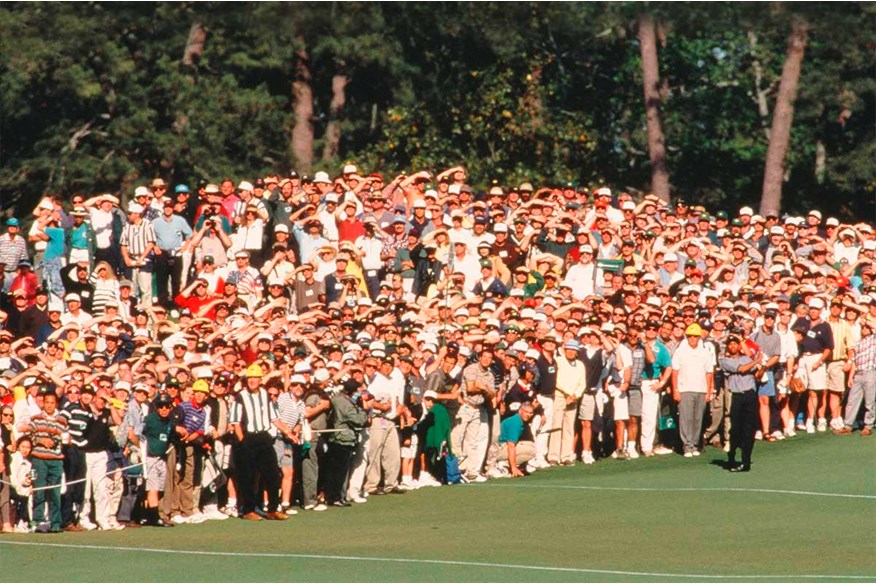
Round two – Augusta meets its match
On Friday, Tiger turned Augusta National into his personal playground.
On a course that historically demanded a more conservative approach, Tiger brings Augusta National to its knees on the second day with a display of fearless aggression and otherworldly driving.
His second-round 66 was fearless, explosive, and clinical. Five birdies, one eagle, one bogey – and a new leader atop the board. The sound of Tiger’s shots? “Like a lightning strike,” one patron told Sports Illustrated.
“He was 50 yards longer than anyone, straighter than anyone, and he never missed a 10-footer all week,” recalled Colin Montgomerie. “You probably won’t ever see that again.”
By day’s end, Woods was leading by three. By the weekend, he’d be out of sight.
Nick Price: “Even after the 40-30 on day one, I don’t know if you’d gotten $10 from any of us on him to win. But what happened over the next three days was something we were all in awe of. This was the start of a new era in golf. He was hitting clubs into the par 4s and par 5s no one had.”
Mark Calcavecchia, Masters opponent: “It was just jaw-dropping. I hit my best drive on 15 one day and had 3-iron in to the green and he had 9-iron in. He was 50 yards beyond where I was hitting it. I was like, ‘How can you hit the ball that far? How the hell is he doing that?
“The thing was, I never looked at him as a minority player, or a black player. I was just a fan of his and knew how great he was. To see the talent and the flair that he had, and to see it so close up, it was just cool to watch.”
MASTERS 1997 LEADERBOARD: ROUND TWO
- T Woods 70-66=136 –8
- C Montgomerie 72-67=139 -5
- C Rocca 71-69=140 -4
- F Couples 72-69=141 -3
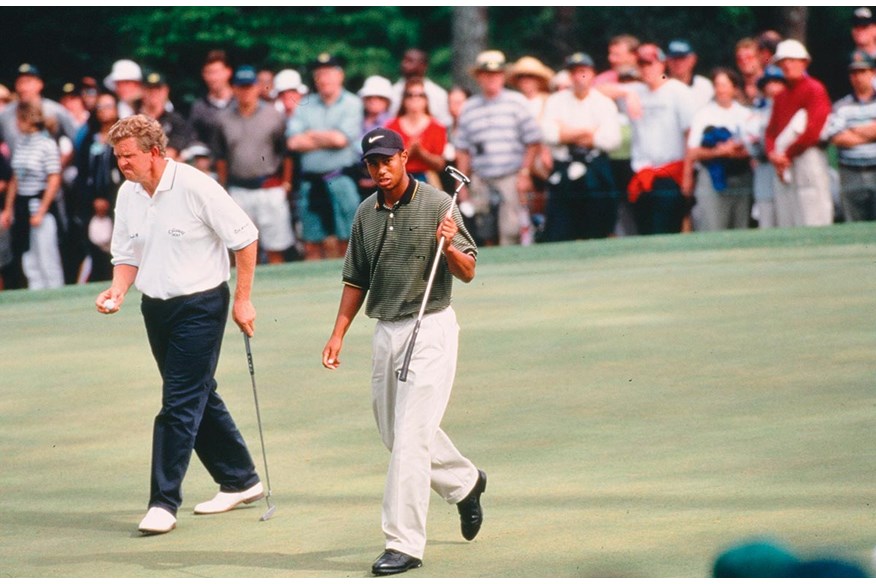
Round three: Takeoff
Paired with second-placed Montgomerie in round three, Woods obliterated any lingering doubt. Monty shot 74. Tiger shot 65. The gap grew to nine.
Colin Montgomerie, Masters opponent: “He was nine-under starting and I was six-under. I remember thinking I had the experience to cope. After all, I was No.1 in Europe at the time and No.2 in the world.
“He was 11 years younger than me but had a focus I’d never seen before. No chat, no small talk. There was no ‘How are the family?’ or ‘Do you have children, Monty?’. It was game on from the first tee.”
“He shot 65 and I shot 74. He is 11 years younger than me but he had a focus beyond anything I’d seen before. It was game on. I had played with Faldo and I had played with Norman but this was different.”
“I hadn’t witnessed golf like that – I really hadn’t. None of us had. And to this day you probably won’t see the like of it again. He was 50 yards longer than anybody at that time, he was straighter than anybody, his iron shots were just impeccable and his mind was so strong.
“It was amazing to watch at close quarters. On the 1st, I hit the back of the bunker and outdrove him. Then he was annoyed, I think. At the 2nd he must have hit it 90 yards past me down the hill. From that drive on the second, it was a different game.
“The thing is, he believed those putts were going to go in. And they did. He never missed a 10-footer all week, which is just crazy at Augusta, especially for such a young guy.”
“He wasn’t interested in interacting with anybody, to be honest. He was in his own zone. For a young man, he was definitely on a mission. I’d never witnessed focus like that before. Faldo was intense but let’s be clear… this guy was in a whole different league.”
Tom Lehman, Masters opponent: “You knew the guy was something special, but as a competitor, you want to hold off [admitting it] as long as you can because you don’t want to give an inch. But at some point, someone proves unequivocally that they’re cut from a different cloth.”
Pete McDaniel: “Earl used to chuckle at people who were amazed how Tiger seemed to fulfil his destiny and dominate the competition. Earl had predicted it, and he wasn’t a braggart. Earl’s rationale was that Tiger had dominated them as juniors so he would beat the heck out of them at another level.”
Ron Sirak: “Tiger was the rare athlete who not only lived up to the hype but exceeded it. He was better than advertised. Once he got the 40 out of the way on the first day, he never hesitated or showed any indication that the moment was going to be too big for him. He previewed everything that week: how he could overpower a course, putt tremendously well, display a short game that, Seve aside, was probably the best ever out there.
“I wrote my story on Saturday night. I’ve never gone into any final round of any tournament feeling as sure of what the outcome would be.”
Bernhard Langer, Masters opponent: “Augusta really played into his hands. He was hitting the ball so far off the tee and he’s a great putter, and that’s what you need to do at Augusta. He just took the course apart with his length.”
Nick Price: “There are guys who can hit golf shots and guys who can win majors. This was a young man amid so much hype who not only delivered but did it in a way most of us had never seen before. Tiger could hit towering shots, manipulate recoveries, was phenomenal around the greens, was driven and had discipline for the game. He would not be suckered into a pin position. He could hit away from a pin with a sand wedge.”
Dave Anderson, The New York Times: “Beyond his physical talents, it was his mental maturity that set him apart from golf’s grinders. You could see his competitive flame burning as he strode the fairways with cool confidence. He reacted with disbelief when he missed a putt that was makeable. And he enjoyed his best shots with a dazzling boyish smile and a quick pump of his right fist.”
Tom Callahan: “During one of the rounds, I forget which, Tiger was in the lead and walking out to the first tee. His mom is there and called out to him. He passed within five yards of her and he just kept walking. I don’t think he heard her but maybe he was just in the zone.”
David Duval, Masters opponent: “You don’t see it often, a player firing on all cylinders, dismantling a golf course and a field. It’s hard to conceive of anyone playing better than Tiger did.”
MASTERS 1997 LEADERBOARD: ROUND THREE
- T Woods 70-66-65=201 –15
- C Rocca 71-69-70=210 -6
- P Stankowski 68-74-69=211 -5
- T Kite 77-69-66=212 -4
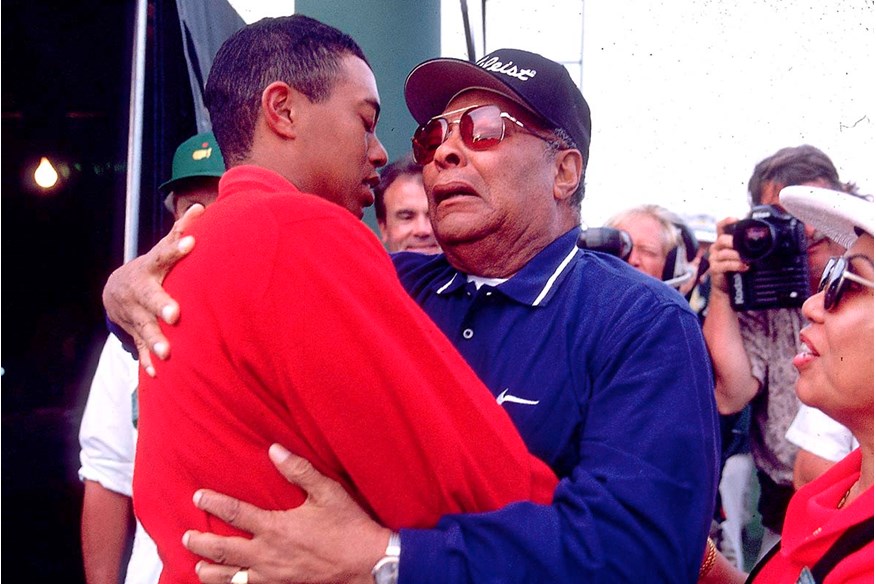
Round four: Coronation Sunday
Final-round pressure? Not for Tiger. Bogeys at five and seven end his streak of 38 consecutive holes without a blemish, but five birdies in all see him post a three-under 69 to record a 12-shot win – still the largest margin of victory in Masters history.
He became the youngest-ever winner at Augusta, and the first black golfer to don the Green Jacket.
“You couldn’t help but notice,” Golf Magazine wrote, “that Chairman Roberts’ rule of golf order had been turned happily upside down – the golfer was Black, and the caddie was white.”
When it was all over, Tiger hugged Fluff, shared an emotional embrace with his dad Earl, and changed the lives of so many watching – whether they were golfers or not.
Renee Powell, the second black woman ever to play on the LPGA Tour, put it plainly: “It was a breakthrough. It gave people hope.”
Colin Montgomerie: “I told the media after the 3rd round, ‘I’ve just witnessed something very special. This is something we haven’t seen before.’ He was nine shots ahead going into the final round and I told them he would win by more.”
Larry Dorman, The New York Times: “It was as good as it gets in sports. I can’t think of anyone in golf who lived up to the hype like Tiger did. Prior to him, there had been a lot of attention on individual players, and they almost never lived up to it. There was some criticism from golf purists about the reaction. But every time he went back to Augusta, pre-fire hydrant, it was a surprise if he didn’t win.”
David Fay, Executive director, USGA: “Tiger was the type of athlete that when he was playing, people best tune in and watch. If they don’t, they’ll feel like they may end up missing something they’ll never see again.”
Ron Sirak: “It was a societal accomplishment as well as an athletic accomplishment. It was as if Jackie Robinson broke the colour barrier in Major League Baseball and Babe Ruth’s home run record in the same season. When Tiger Woods had his A game, everybody was playing for second place.”
- THE MASTERS: The history and menus of Augusta’s Champions Dinner
Renee Powell, second African-American player on the LPGA Tour (1967-1980): “It was the first time my father, William, and I had been to the Masters. Tiger had a tough start, but then played like he owned the course.
“For him to win there, not by one shot but by 12, being a person of color – it would not have had the same effect if it had been the US Open or PGA Championship.
“It didn’t mean that every minority kid was going to pick up a golf club as a result, but because of the challenges in the past, it was a breakthrough and gave people hope.”
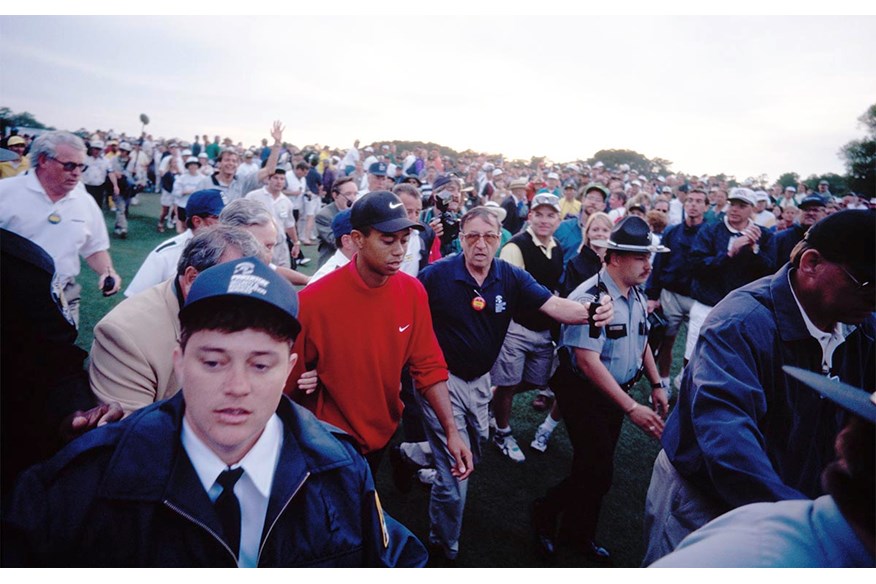
Ben Crenshaw, Masters opponent: “It was a zenith, an earth-shaking moment. It was a combination of power and finesse that no one had seen around there. His prowess was just incredible. He had the weight of the world on his shoulders for a lot of people who loved the game, and he achieved a landmark victory. It was one of those things that nobody said would happen.”
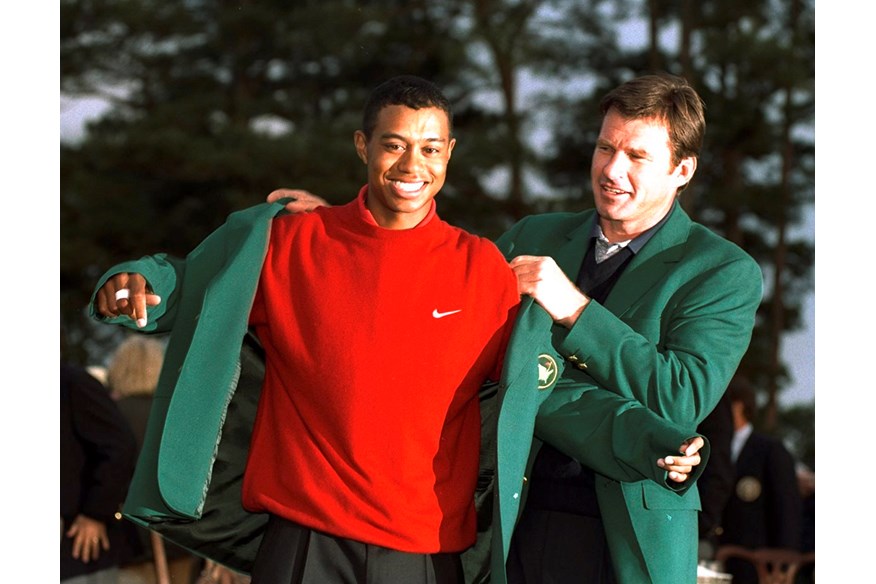
Pete McDaniel: “I was at the rental house on Sunday night where Tiger and his family were staying. Everybody was festive, but Tiger was kind of guarded in that he couldn’t really turn it loose. He realized there was a photographer and a couple of reporters there. Tiger didn’t want any pictures of drinking.
“At a certain point, Tiger was nowhere to be found. Tida went upstairs and said, ‘Pete come here,’ and we tiptoed up there and looked in his room. He was on the bed, asleep, cuddling the green jacket like it was a teddy bear. This guy who was so ferocious on the course was really a kid at heart.”
MASTERS 1997 LEADERBOARD: FINAL LEADERBOARD
- Tiger Woods 70-66-65-69=270 –18
- Tom Kite 77-69-66-70=282 -6
- Tommy Tolles 72-72-72-67=283 -5
- Tom Watson 75-68-69-72=284 -4
-
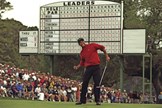 The story of golfer Tiger Woods' 1997 Masters victory, told by the players, officials and journalists who witnessed it.
The story of golfer Tiger Woods' 1997 Masters victory, told by the players, officials and journalists who witnessed it.
-
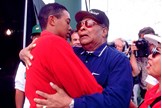 Tiger Woods celebrates his 1997 Masters victory with father Earl.
Tiger Woods celebrates his 1997 Masters victory with father Earl.
-
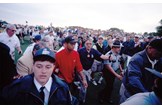 A taste of things to come as security help Tiger Woods through the huge Masters crowds.
A taste of things to come as security help Tiger Woods through the huge Masters crowds.
-
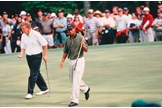 Tiger Woods acknowledges the crowds as he blows Colin Montgomerie away in the third round of the 1997 Masters.
Tiger Woods acknowledges the crowds as he blows Colin Montgomerie away in the third round of the 1997 Masters.
-
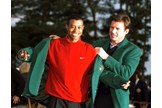 Tiger Woods remains the youngest player to win The Masters.
Tiger Woods remains the youngest player to win The Masters.
-
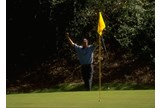 Tiger Woods celebrates holing a chip for birdie on the 12th hole of his opening round at the 1997 Masters.
Tiger Woods celebrates holing a chip for birdie on the 12th hole of his opening round at the 1997 Masters.
-
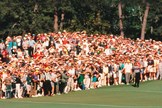 Even before winning his first Major, Tiger Woods was drawing huge golf galleries.
Even before winning his first Major, Tiger Woods was drawing huge golf galleries.
